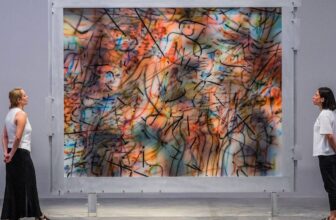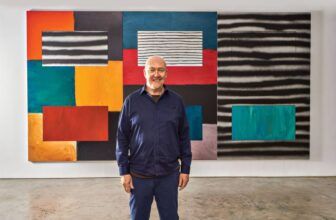What Was Richard Diebenkorn Known For
Richard Diebenkorn is one of the most influential American painters of the 20th century, celebrated for his contributions to both Abstract Expressionism and the Bay Area Figurative Movement. His work, rich in texture, color, and spatial complexity, bridges the gap between abstraction and representation, forming a deeply personal and distinctive voice in American art. With a career spanning over four decades and a body of work that includes hundreds of paintings, drawings, and prints, Diebenkorn’s artistic legacy continues to inspire collectors, artists, and critics alike.
Who Was Richard Diebenkorn?
Born on April 22, 1922, in Portland, Oregon, Richard Diebenkorn grew up in San Francisco, California. His artistic journey began in earnest at Stanford University, where he studied under notable instructors and became influenced by Edward Hopper’s use of light and space. Following a stint in the U.S. Marine Corps during World War II, he returned to his art studies, eventually earning a Master of Fine Arts from the University of New Mexico.
Diebenkorn’s artistic path was marked by continual evolution. Initially aligned with Abstract Expressionism, he later became a central figure in the Bay Area Figurative Movement during the 1950s and 60s, only to return to abstraction in the latter part of his career with his acclaimed “Ocean Park” series. His work is characterized by its formal rigor, lyrical use of color, and a deep engagement with the act of painting itself.
Richard Diebenkorn is best known for his “Ocean Park” series, a monumental body of abstract works created between 1967 and 1988, while he lived in Southern California. These large-scale paintings, named after the Ocean Park neighborhood in Santa Monica where he maintained a studio, are composed of geometric shapes, luminous color fields, and layered brushstrokes. They reflect a sophisticated balance between structure and spontaneity, evoking landscape, architecture, and atmosphere without directly representing any specific scene.
Prior to this phase, Diebenkorn was also recognized for his figurative work, particularly during the 1950s and early 60s, when he diverged from abstraction to focus on still lifes, portraits, and landscapes. This period was crucial in American art history, as many artists began to blend abstract techniques with representational subjects.
His ability to move fluidly between abstraction and figuration, and to imbue both with a sense of meditative beauty and intellectual rigor, is a defining feature of his career. He was an artist deeply committed to the process of making art—his paintings reveal their construction through visible edits, changes in direction, and overpainting, offering a window into the artist’s thoughts and decisions.
How Did Richard Diebenkorn Make His Artwork?
Diebenkorn’s artistic process was meticulous, exploratory, and intuitive. He often began with an abstract or gestural idea and then developed it over time through a process of layering, editing, and refinement. He would paint over earlier passages, scrape back layers, and adjust colors and forms until the composition achieved the desired balance and resonance.
In both his abstract and figurative phases, Diebenkorn emphasized spatial tension and compositional harmony. His paintings frequently exhibit a grid-like structure that suggests architecture or aerial views of landscapes, especially in the Ocean Park works. Despite their apparent simplicity, these paintings are the result of complex decisions about proportion, balance, and surface texture.
His color palette was another hallmark of his work—Diebenkorn had a sophisticated sense of color, often using subtle variations of tone and hue to create depth and mood. Blues, ochres, greens, and pinks dominate his canvases, often applied with visible brushwork that enhances the surface quality of the painting.
What Art Style Is Richard Diebenkorn Associated With?
Diebenkorn is primarily associated with two major styles:
Abstract Expressionism: Early in his career, Diebenkorn painted gestural, non-representational canvases aligned with the Abstract Expressionist movement. His early works from the late 1940s and early 1950s exhibit energetic brushwork and a strong emphasis on the physical act of painting.
Bay Area Figurative Movement: In the 1950s, he became a leading figure in this California-based movement, which sought to reintroduce the human figure and representational elements into modern painting. This group included artists like David Park and Elmer Bischoff, with whom Diebenkorn shared a commitment to painterly technique and expressive realism.
Later, in his Ocean Park series, he developed a unique form of lyrical abstraction that drew from both these traditions, as well as from European modernists like Henri Matisse, whose influence is especially evident in Diebenkorn’s use of color and composition.
What Materials Did Richard Diebenkorn Use?
Diebenkorn primarily worked with oil on canvas, particularly for his larger, more iconic works. However, he was also a skilled draftsman and printmaker. His works on paper, including charcoal drawings, gouaches, watercolors, and etchings, are highly regarded and demonstrate his exceptional line quality and sensitivity to surface.
He was known for reworking his canvases multiple times, which often required durable materials that could withstand scraping and overpainting. His materials and techniques allowed him to explore surface and space in increasingly sophisticated ways throughout his career.
How Famous Is Richard Diebenkorn?
Today, Richard Diebenkorn is regarded as one of the most important American painters of the post-war period. His reputation has grown significantly since his death in 1993, and he is celebrated not only for his technical mastery and innovation but also for the emotional depth and contemplative quality of his work.
Major museums around the world hold his works in their permanent collections, including:
The Museum of Modern Art (MoMA), New York
The San Francisco Museum of Modern Art (SFMOMA)
The Whitney Museum of American Art
The National Gallery of Art, Washington, D.C.
The Los Angeles County Museum of Art (LACMA)
He has been the subject of numerous retrospectives and scholarly studies. His Ocean Park series, in particular, is considered a high point in modern American abstraction, and his influence can be seen in generations of contemporary painters.
How Many Artworks Does Richard Diebenkorn Have?
While an exact number is difficult to determine due to the private nature of some collections and the breadth of his output, it is estimated that Diebenkorn created several hundred major works over his lifetime, including paintings, works on paper, and prints. The Richard Diebenkorn Foundation, established to preserve and promote his legacy, has been cataloging and archiving his extensive oeuvre, which includes:
Approximately 145 paintings in the Ocean Park series alone
Dozens of figurative works from the 1950s and 60s
Numerous earlier abstract paintings from the Albuquerque, Urbana, and Berkeley periods
Hundreds of drawings and works on paper
What Is Richard Diebenkorn’s Famous Artwork?
Among Diebenkorn’s most celebrated works, the following stand out:
“Ocean Park #54” (1972) – Held by the San Francisco Museum of Modern Art, this large-scale painting exemplifies his mature style with its pastel hues and complex geometry.
“Ocean Park #79” (1975) – A prime example of the Ocean Park series, known for its architectural lines and luminous palette. It sold for $13.5 million at Christie’s in 2018.
“Cityscape #1” (1963) – A striking urban landscape from his figurative period, showing the transition between representation and abstraction.
“Seated Woman” (1965) – A masterpiece of the Bay Area Figurative Movement, showing his ability to infuse the figure with psychological weight and painterly sensitivity.
Untitled (Berkeley series) – Works from the Berkeley period (1953–1966) also rank highly in both market and critical value, as they bridge his abstract and figurative concerns.
How Much Does Richard Diebenkorn’s Art Cost?
Richard Diebenkorn’s work commands some of the highest prices among post-war American artists. His auction records reflect a strong and growing market for both his paintings and his works on paper. Here are a few highlights:
“Ocean Park #126” sold for $23.9 million at Christie’s in 2018, setting a new auction record for the artist.
Other major paintings regularly fetch between $5 million and $15 million, depending on size, provenance, and period.
Works on paper, such as watercolors and gouaches, often sell for $100,000 to $500,000, with some exceptional pieces exceeding that.
Early figurative works and mid-century paintings can command prices between $1 million and $8 million at auction or through private sales.
Diebenkorn’s work is highly sought after by collectors, particularly those with a focus on modern American art, and his reputation continues to grow as new audiences are introduced to his work through exhibitions and scholarship.
Richard Diebenkorn’s Influence
Richard Diebenkorn’s art is a testament to the power of observation, contemplation, and the deep emotional resonance of color and form. Throughout his career, he remained committed to exploration and growth, never settling into a single style or formula. His paintings are not only visually captivating but intellectually and emotionally rich, inviting viewers to lose themselves in their layered surfaces and quiet intensity.
Today, more than 30 years after his death, Diebenkorn’s legacy continues to thrive. His influence is felt in contemporary painting, his works are coveted by major institutions and private collectors, and his name remains synonymous with the best of American modernism. Whether through the geometric poetry of the Ocean Park series or the evocative stillness of his figurative paintings, Richard Diebenkorn offers an enduring vision of what painting can be: a space of infinite depth, subtlety, and human presence.




